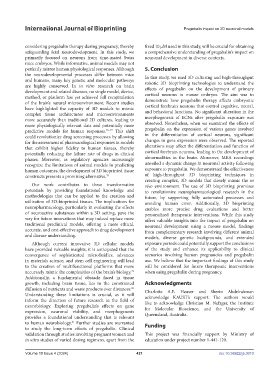Page 429 - IJB-10-4
P. 429
International Journal of Bioprinting Pregabalin impact on 3D neuronal models
considering pregabalin therapy during pregnancy, thereby fixed 10 µM used in this study, will be crucial for obtaining
safeguarding fetal neurodevelopment. In this study, we a comprehensive understanding of pregabalin’s impact on
primarily focused on neurons from time-mated Swiss neuronal development in diverse contexts.
mice embryos. While informative, animal models may not
perfectly mirror human physiological responses. Although 5. Conclusion
the neurodevelopmental processes differ between mice In this study, we used 3D culturing and high-throughput
and humans, many key genetic and molecular pathways robotic 3D bioprinting technologies to understand the
are highly conserved. In in vitro research on brain effects of pregabalin on the development of primary
development and related diseases, no single model, device, cortical neurons in mouse embryos. The aim was to
method, or platform has yet achieved full recapitulation demonstrate how pregabalin therapy affects embryonic
of the brain’s natural microenvironment. Recent studies
have highlighted the capacity of 3D models to mimic cortical forebrain neurons that control cognitive, neural,
complex tissue architectures and microenvironments and behavioral functions. No significant alteration in the
more accurately than traditional 2D cultures, leading to morphogenesis of ECNs after pregabalin exposure was
more physiologically relevant data and potentially more observed. Nonetheless, when we examined the effects of
predictive models for human responses. 75–77 This shift pregabalin on the expression of various genes involved
could revolutionize drug screening processes by allowing in the differentiation of cortical neurons, significant
for the assessment of pharmacological responses in models changes in gene expression were observed. The reported
that exhibit higher fidelity to human tissues, thereby alterations may affect the differentiation and function of
potentially reducing the failure rate of drugs in clinical cortical forebrain neurons, leading to the development of
phases. Moreover, as regulatory agencies increasingly abnormalities in the brain. Moreover, MEA recordings
recognize the limitations of animal models in predicting unveiled a dynamic change in neuronal activity following
human outcomes, the development of 3D bioprinted tissue exposure to pregabalin. We demonstrated the effectiveness
constructs presents a promising alternative. 78 of high-throughput 3D bioprinting techniques in
creating complex, 3D models that closely mimic the in
Our work contributes to these transformative vivo environment. The use of 3D bioprinting promises
potentials by providing foundational knowledge and to revolutionize neuropharmacological research in the
methodologies that can be applied to the creation and future, by supporting fully automated processes and
utilization of 3D-bioprinted tissues. The implications for avoiding human error. Additionally, 3D bioprinting
neuropharmacology, particularly in evaluating the effects enables more precise drug evaluations and better
of neuroactive substances within a 3D setting, pave the personalized therapeutic interventions. While this study
way for future innovations that may indeed replace more offers valuable insights into the impact of pregabalin on
traditional preclinical models, offering a more ethical, neuronal development using a mouse model, findings
accurate, and cost-effective approach to drug development from complementary research involving different animal
and disease understanding. models, diverse genetic backgrounds, and extended
Although current innovative 3D cellular models exposure periods could potentially support the conclusions
have provided valuable insights, it is anticipated that the of the study and enhance its applicability to clinical
convergence of sophisticated microfluidics, advances scenarios involving human pregnancies and pregabalin
in materials science, and stem cell engineering will lead use. We believe that the important findings of this study
to the creation of multifunctional platforms that more will be considered for future therapeutic interventions
accurately mimic the complexities of the brain’s biology. when using pregabalin during pregnancy.
79
Additionally, a fundamental obstacle faced in tissue
growth, including brain tissue, lies in the constrained Acknowledgments
diffusion of nutrients and waste products over distances. Charlotte A.E. Hauser and Sherin Abdelrahman
80
Understanding these limitations is crucial, as it will acknowledge KAUST’s support. The authors would
inform the direction of future research in the field of like to acknowledge Christian M. Nefzgar, the Institute
neurobiology. Exploring pregabalin’s effects on gene for Molecular Bioscience, and the University of
expression, neuronal viability, and morphogenesis
provides a foundational understanding that is relevant Queensland, Australia.
81
to human neurobiology. Further studies are warranted Funding
to study the long-term effects of pregabalin. Clinical
validation through studies involving pregnant women and This project was financially support by Ministry of
in vitro studies of varied dosing regimens, apart from the education under project number 1-441-120.
Volume 10 Issue 4 (2024) 421 doi: 10.36922/ijb.3010

